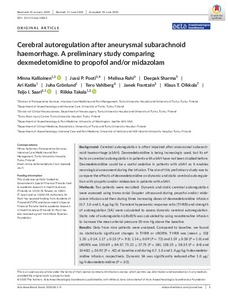Cerebral autoregulation after aneurysmal subarachnoid haemorrhage. A preliminary study comparing dexmedetomidine to propofol and/or midazolam
Kallioinen M; Posti JP; Rahi M; Sharma D; Katila A; Gronlund J; Vahlberg T; Frantzen J; Olkkola KT; Saari TI; Takala R
Cerebral autoregulation after aneurysmal subarachnoid haemorrhage. A preliminary study comparing dexmedetomidine to propofol and/or midazolam
Kallioinen M
Posti JP
Rahi M
Sharma D
Katila A
Gronlund J
Vahlberg T
Frantzen J
Olkkola KT
Saari TI
Takala R
WILEY
Julkaisun pysyvä osoite on:
https://urn.fi/URN:NBN:fi-fe2021042824252
https://urn.fi/URN:NBN:fi-fe2021042824252
Tiivistelmä
Background Cerebral autoregulation is often impaired after aneurysmal subarachnoid haemorrhage (aSAH). Dexmedetomidine is being increasingly used, but its effects on cerebral autoregulation in patients with aSAH have not been studied before. Dexmedetomidine could be a useful sedative in patients with aSAH as it enables neurological assessment during the infusion. The aim of this preliminary study was to compare the effects of dexmedetomidine on dynamic and static cerebral autoregulation with propofol and/or midazolam in patients with aSAH. Methods Ten patients were recruited. Dynamic and static cerebral autoregulation were assessed using transcranial Doppler ultrasound during propofol and/or midazolam infusion and then during three increasing doses of dexmedetomidine infusion (0.7, 1.0 and 1.4 mu g/kg/h). Transient hyperaemic response ratio (THRR) and strength of autoregulation (SA) were calculated to assess dynamic cerebral autoregulation. Static rate of autoregulation (sRoR)% was calculated by using noradrenaline infusion to increase the mean arterial pressure 20 mm Hg above the baseline. Results Data from nine patients were analysed. Compared to baseline, we found no statistically significant changes in THRR or sROR%. THRR was (mean +/- SD) 1.20 +/- 0.14, 1.17 +/- 0.13 (P = .93), 1.14 +/- 0.09 (P = .72) and 1.19 +/- 0.18 (P = 1.0) and sROR% was 150.89 +/- 84.37, 75.22 +/- 27.75 (P = .08), 128.25 +/- 58.35 (P = .84) and 104.82 +/- 36.92 (P = .42) at baseline and during 0.7, 1.0 and 1.4 mu g/kg/h dexmedetomidine infusion, respectively. Dynamic SA was significantly reduced after 1.0 mu g/kg/h dexmedetomidine (P = .02). Conclusions Compared to propofol and/or midazolam, dexmedetomidine did not alter static cerebral autoregulation in aSAH patients, whereas a significant change was observed in dynamic SA. Further and larger studies with dexmedetomidine in aSAH patients are warranted.
Kokoelmat
- Rinnakkaistallenteet [27094]
